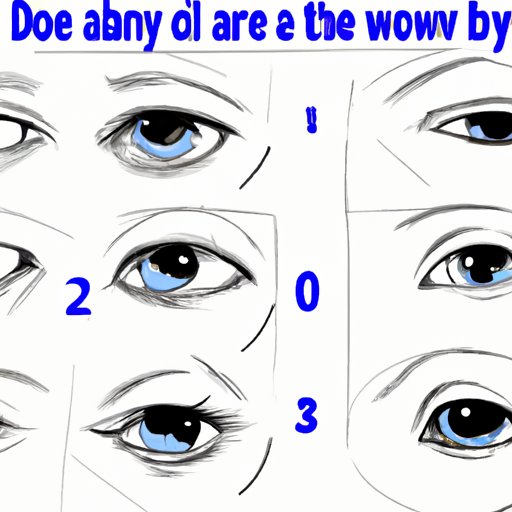
Introduction
Eyes are arguably the most impactful element in any realistic drawing or painting. They are often the focal point of a piece and can convey emotion, personality, and mood. Because of this, learning how to draw eyes is an essential skill for any beginning artist. It can also be one of the most challenging aspects of learning to draw, which is why in this article, we’ll provide you with a step-by-step guide to creating stunning eyes that look realistic.
Step-by-Step Breakdown of the Process of Drawing Eyes
The first step to drawing realistic eyes is observation. Start by studying the structure of eyes and familiarizing yourself with the various parts, such as the iris, pupil, eyelids, and lashes. Observe how they relate to each other and how shadows and highlights affect the overall appearance.
Next, take a look at the shape of the eye as a whole. Depending on the angle and expression you’re trying to convey, the eye’s shape will vary. Pay particular attention to the corners of the eye, where the eyelids meet and create a distinctive shape that can vary depending on the person or animal you’re drawing.
Once you’ve observed these details, you can start sketching the basic shape of the eye. Start with a circle or oval to outline the general shape, then add more detail as you go, such as the eyelids and iris. Be sure to keep the shape consistent with what you observed earlier.
Next, start shading the eye to give it depth and dimension. Begin with a light layer of shading, making sure to follow the contours of the eye. You can then gradually add deeper shadows as needed and experiment with different shading techniques to create various textures and surfaces.
Finally, add the finishing details, such as highlights on the pupil and eyelashes, to create a sense of realism and liveliness. Keep in mind that the details should vary depending on the expression and mood of the eye you’re drawing.
As you practice, you’ll become more comfortable with the process and can start experimenting with different techniques and styles to create eyes that are uniquely yours.
Using Diagrams and Visual Aids to Illustrate the Process of Drawing Eyes
In addition to written instructions, diagrams and visual aids can be immensely helpful in assisting you in understanding the process of drawing eyes. Follow along with the diagrams provided to help you ensure you stay on track with each step. Try to follow each step closely while looking at the visual aid to create the best possible result.
Common Mistakes and Pitfalls When Drawing Eyes
When learning how to draw eyes, beginners often encounter some common pitfalls and mistakes. For example, it’s easy to draw symmetrically when, in reality, most eyes aren’t perfectly symmetrical. Another frequent issue is the tendency of some beginners to oversaturate the eye with shading, which can make it look flat and lifeless.
An easy way to avoid these mistakes is to pay close attention to references and take your time. Don’t be afraid to start over if you make a mistake. By working methodically and focusing on each step, you’ll create an eye that looks realistic and expressive.
Actionable Tips and Advice for Practice
The most important aspect of learning to draw eyes is consistent practice. Set aside a few hours each week to practice drawing eyes so that you can build your skills and confidence. Try different techniques to see what works best for you, such as shading with graphite, charcoal, or colored pencils, or using a combination of these mediums.
Another great way to practice is by studying photographs and other references of eyes and trying to recreate them as accurately as possible. This exercise can improve your observational skills and show you how to apply those details to your drawings.
Real-Life Examples and Case Studies of Artists Who Have Mastered the Art of Drawing Eyes
Looking at other artists’ work can be an excellent way to learn and get inspiration for your own drawings. Many professional artists have mastered the art of drawing eyes, and their work can teach you a lot about techniques, styles, and expressions.
One example of an artist known for their incredible eye-drawing skills is Mike Bohatch. His illustrations often feature delicately drawn eyes that convey emotion and depth. Additionally, Alphonso Dunn, an educator, and artist, has a tutorial on his website that provides an excellent breakdown of the steps involved in drawing realistic eyes.
The Importance of Eyes in Art
Eyes play an integral role in conveying emotion, personality, and overall mood in a piece of art. Being able to create eyes that convey realistic emotions is an essential skill for any artist. The eyes are typically one of the first things someone will look to in any portrait or drawing, making them one of the most significant factors in capturing a person’s likeness and their essence. Whether you’re drawing a human, animal, or any other subject, mastering the art of drawing eyes can be integral to bringing your art to life and creating a compelling piece.
Conclusion
Drawing eyes is an essential skill for any artist, but it can be challenging for beginners to master. In this comprehensive guide, we’ve provided you with step-by-step instructions, visual aids, tips, and inspiration to help you create stunning eyes that look realistic and expressive. Remember that practice is key to improving your skills, and with time, you can develop the confidence and techniques to make your eyes unique.




